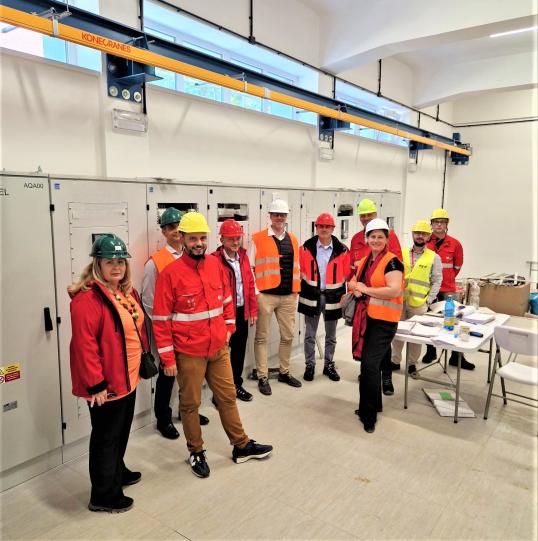
Last month, we visited the infrastructure sites of two flagship projects supported by CEF Energy: ACON Smart Grids (Czechia-Slovakia) and Danube InGrid (Slovakia-Hungary). Both share the common goals of fostering the integration of the electricity market across borders; ensuring quality, safety and reliability of electricity supply; and enhancing the integration of decentralised Renewable Energy Sources (RES), new energy consumers, and e-mobility.
Both projects stand out for its work in modernising and improving the distribution grid's efficiency at different locations in the Czech and Slovak territories, from the construction of overhead lines, underground cables, primary and secondary substations and border and cross-border overhead lines; to the installation of smart automatic and remote-controlled elements, new communication systems and integrated IT solutions. All these novelties result in an increase on the observability and controllability of the grid, allowing for a faster and more accurate reaction in case of failure, reducing disconnection times, and increasing the efficiency in the management of the grid.
In recent years, some of the regions covered by these two projects have been experiencing some societal changes, with more citizens moving from big cities to new residential areas. The new households are equipped with home renewable energy solutions (such as photovoltaic panels, electric heating, e-mobility) promoting greener behaviours, self-consumption and reducing both carbon footprints and energy costs. This shift, driven by the energy crisis and rising prices, has increased the demand for connecting new decentralised renewable electricity generation sources among households and enterprises, needing further development of the electrical distribution infrastructure to match this demand.
In this context, we were glad to attend the inauguration of the 110/22 kV Mierovo smart substation, which is part of the Danube InGrid project and built to cover the growing demand for integrating renewable energy sources to the grid, in particular in the Western Slovakia region.
Olivier Silla, Head of Department at CINEA, attended the event and said:
“Danube InGrid started four years ago as an innovative smart grid initiative between Slovakia and Hungary. By now, the modern-digital infrastructure implemented already represents a transformative step towards a more secure, flexible, and decarbonised electricity system in the two Member States, while bringing immediate benefits to local communities.”
| We also visited the secondary digital transformer station in Samorin, part of the same project. The station complements primary substations such as Mierovo, by completing the final step-down of the voltage, ensuring efficient and safe distribution of electricity to the end user. They are the forefront infrastructure enabling the integration of decentralised renewables and e-mobility. |
| The trip also included a visit to the construction of the urban Brno-sever substation in Czechia, developed as part of the ACON project. This type of urban compact gas-insulated substation saves space, reduces the risk of outages, and enhances safety. Ideal for urban areas due to their small footprint and reduced environmental impact, these substations will significantly increase the reliability of electricity supply in Brno once completed. |
| Finally, we visited the construction of a 110 kV overhead line from Borský Svätý Jur substation to Holíč substation in Slovakia. Once completed, it will enhance the capacity to integrate distributed renewable energy sources in Western Slovakia. This line is part of ACON’s strategy to modernise and strengthen the distribution network in border areas and improve cross-border cooperation during emergencies and other critical situations. For example, during the large-scale outage in South Moravia (Czechia) in 2021 caused by severe storms and a devastating tornado, the new border and cross-border lines already provided emergency assistance and will offer even greater support in the future. |
“The smart grids projects ACON and Danube InGrid show that by working together, Czechia, Slovakia and Hungary are not only improving their own energy security but also contributing to a stronger and safer European grid and energy network. It is a clear example on how European programmes such as Connecting Europe Facility are instrumental to build such infrastructure projects that are key in the clean energy transition,” said Oliver Silla.
Background
Both ACON Smart Grids and Danube InGrid have received the status of PCI (Project of Common Interest), what allows them to benefit from an accelerated permit granting process and improved regulatory treatment as well as to access CEF Energy funding.
ACON Smart Grids is benefiting from CEF Energy funding since 2018 with over EUR 91 million. The project is expected to be completed by December 2024. More information: https://www.acon-smartgrids.cz/ or LinkedIn
Danube InGrid is co-funded by CEF Energy since 2020 and has received EUR 102 million. The project should be completed by December 2025. More information: https://danubeingrid.eu/ or LinkedIn
Details
- Publication date
- 15 October 2024
- Author
- European Climate, Infrastructure and Environment Executive Agency





